How to Read Medication Guides for Risk and Monitoring Advice
When you pick up a new prescription, the pharmacist hands you a small paper insert. It looks like just another piece of paperwork. But that little guide could be the difference between staying safe and ending up in the hospital. These are Medication Guides-FDA-mandated documents designed to tell you exactly what could go wrong and what you need to do to prevent it. They’re not optional. They’re not filler. They’re your personal safety checklist for high-risk drugs.
Why Medication Guides Exist
Not every drug comes with one. The FDA only requires Medication Guides for medications with serious, preventable risks. That means drugs that can cause liver failure, dangerous drops in blood cells, life-threatening allergic reactions, or sudden mood changes. Right now, about 150 of these guides exist for drugs across 30 different categories-from antidepressants and blood thinners to immune suppressants and cancer treatments. The goal? Make sure you understand the danger before you take it. The FDA requires these guides to be written at a 6th to 8th grade reading level. No jargon. No vague warnings like "may cause side effects." Instead, they say things like: "Can cause serious liver damage" or "About 1 in 200 people taking this drug may develop a dangerous drop in white blood cells."The Seven Sections You Must Read
Every Medication Guide follows the same structure. Don’t skip any section. Here’s what to look for:- What is the most important information I should know about [drug name]? This is where the FDA puts its strongest warnings. It’s often called the "black box" warning in plain language. If your drug causes sudden heart problems, liver damage, or suicidal thoughts, this section says it clearly. Read this first. Always.
- What should I tell my healthcare provider before taking [drug name]? This tells you what health conditions or other drugs could make this medication dangerous for you. If you have liver disease, kidney problems, or are pregnant, this section will tell you if you should avoid it.
- What are the possible or reasonably likely serious side effects of [drug name]? This is the monitoring section. This is where you find out what tests you need and how often. Look for phrases like: "get your blood tested regularly," "check your liver function every 3 months," or "call your doctor immediately if you notice unusual bruising or bleeding."
- How should I take [drug name]? This section ties the monitoring to your schedule. It doesn’t just say "get blood tests." It says: "Your doctor should test your blood before you start and every 3 months while taking this medicine." It even tells you what to do if your dose changes.
- What should I avoid while taking [drug name]? Alcohol? Sunlight? Driving? Some drugs make you dizzy. Others make you burn easily. This section tells you exactly what to stop doing.
- What are the possible side effects? This lists common but less dangerous reactions-headaches, nausea, dry mouth. Don’t ignore it, but focus more on the serious side effects above.
- How should I store [drug name]? Keep it away from kids. Don’t leave it in the car. Some drugs break down in heat or light. This part keeps your medicine safe until you take it.
How to Spot the Red Flags
There are seven phrases that should jump out at you. These mean you need to act:- "Get blood tests regularly" - This isn’t a suggestion. It’s a requirement.
- "Call your doctor immediately if..." - These are your warning signs. Write them down.
- "Do not stop taking without talking to your doctor" - Stopping suddenly can cause seizures, heart problems, or rebound symptoms.
- "Avoid sunlight exposure" - Some drugs make your skin burn in minutes.
- "Do not drink alcohol" - Even one drink can increase liver damage or dizziness.
- "May impair driving ability" - If you feel drowsy or dizzy, don’t get behind the wheel.
- "Keep all scheduled appointments" - These aren’t optional checkups. They’re lifesavers.
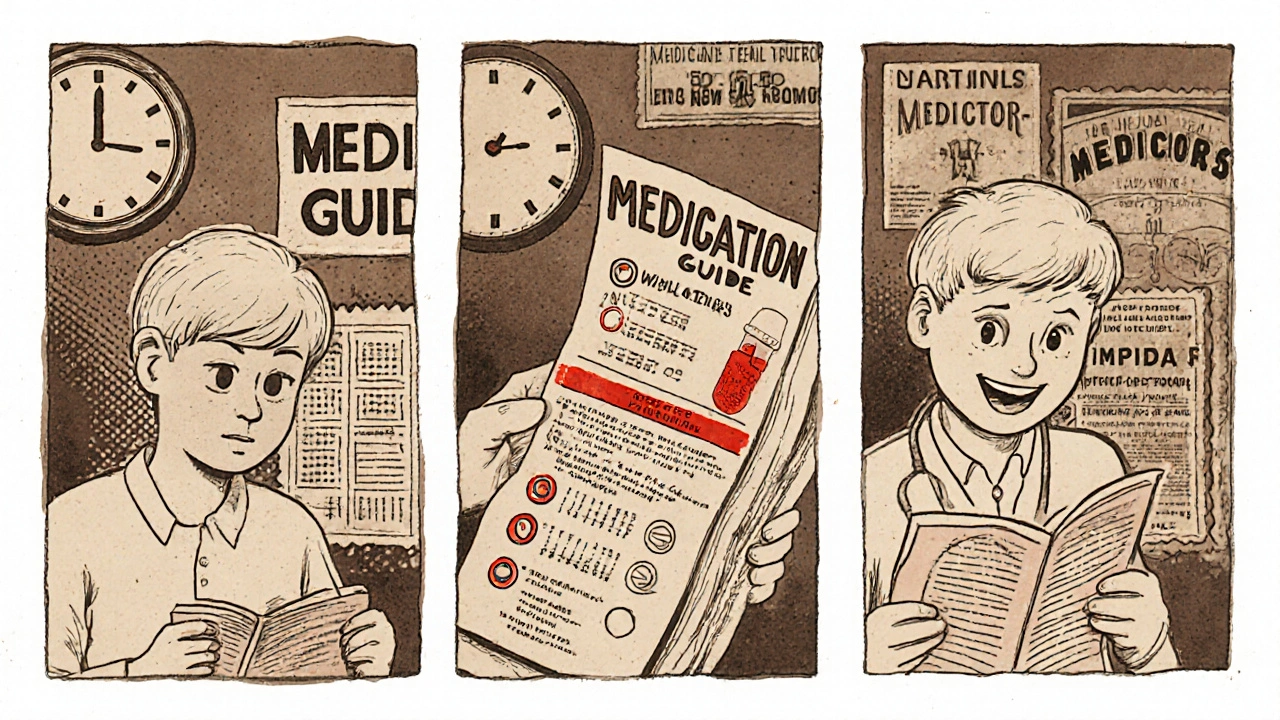
Real Examples That Save Lives
Take warfarin (Coumadin), a blood thinner. Its Medication Guide says: "Your INR should be checked at least once a month. If your dose is changed, check it more often." It also lists exact symptoms: "Unusual bruising, bleeding that lasts a long time, pink or red urine, black or bloody stools." If you notice any of these, you go to the ER-not wait until tomorrow. Antidepressants like sertraline (Zoloft) or fluoxetine (Prozac) all say the same thing: "Pay close attention to any changes, especially sudden changes, in mood, behavior, thoughts, or feelings. This is very important when the medicine is started or when the dose is changed." The risk is highest in the first 4 to 6 weeks. If you feel worse, not better, you don’t just "wait it out." You call your doctor. Clozapine (Clozaril), used for severe schizophrenia, has one of the most detailed guides: "About 1 in 200 people taking clozapine may develop agranulocytosis-a dangerous drop in white blood cells. You must get weekly blood tests for the first 6 months." Miss one test? You risk death.How to Actually Use the Guide
Reading it once isn’t enough. Here’s how to make it work:- Read it before your first dose. Spend 3 minutes. Highlight the monitoring section.
- Review it before every refill. Things change. Your doctor might add a new warning. The guide updates within 30 days of any safety change.
- Check for updates during treatment. If you’ve been on the drug for months, look again. A new risk might have been added.
- Highlight every word like "test," "monitor," "check," or "measure" in yellow.
- Circle every time frame: "weekly," "monthly," "every 3 months," "immediately."
- Underline any symptoms that say "call your doctor immediately" in red.
- Green = Normal symptoms (mild headache, tiredness)
- Yellow = Watch for these (slight dizziness, mild nausea)
- Red = Call your doctor or go to the ER (chest pain, bleeding, confusion, fever)
What If You Don’t Get the Guide?
The FDA says pharmacies must give you the Medication Guide every time you fill the prescription. But in 2022, 41% of independent pharmacies failed to do so consistently. If you don’t get one:- Ask for it. Say: "I need the Medication Guide for this drug. It’s required by law."
- If they say they don’t have it, ask them to call the manufacturer or check DailyMed (the NIH’s free online database).
- Go to dailymed.nlm.nih.gov and search your drug name. You can download the official guide for free.
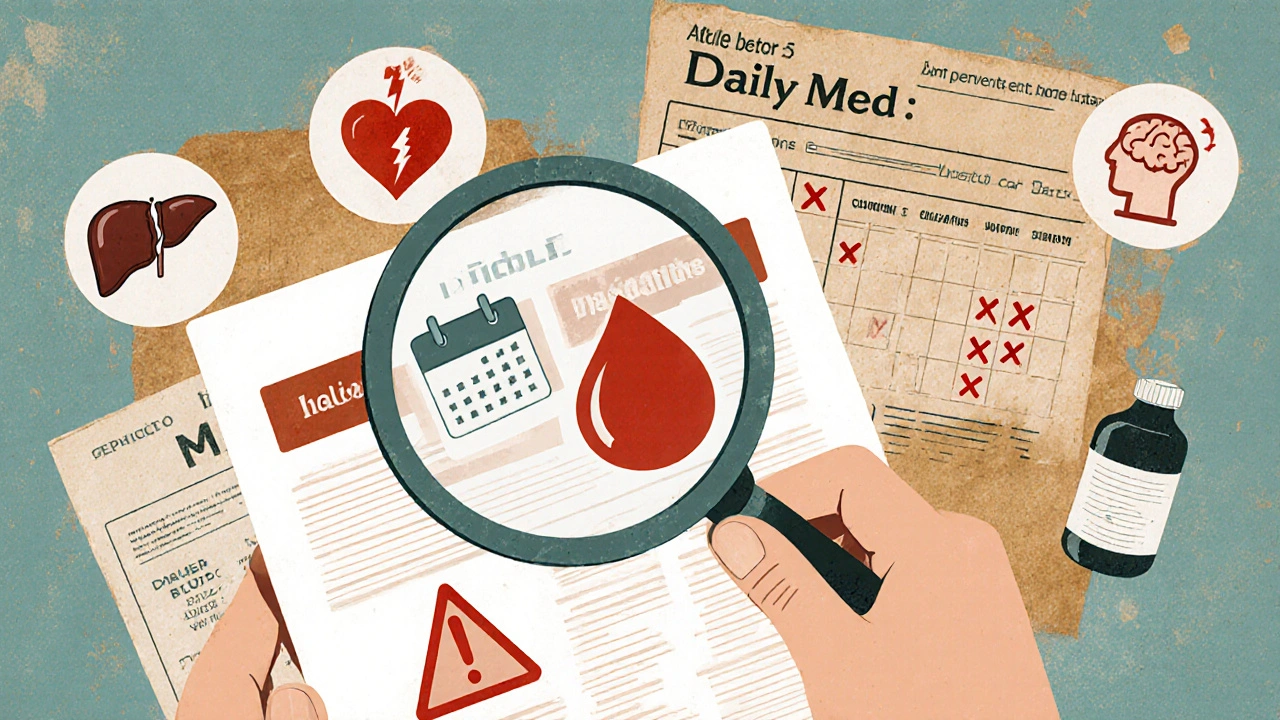
What’s Changing in 2025?
The FDA is making Medication Guides better. By 2026, they’ll require pictograms-simple icons showing when to test your blood or when to call your doctor. That helps people who struggle with reading. Some companies are testing AI-powered guides. Pfizer’s pilot program uses your medical history to highlight only the risks that apply to you. Early results show 63% better understanding. Medicare Part D will start penalizing pharmacies in 2025 if they don’t hand out guides. That means pharmacies will be forced to get it right.Why This Matters
The FDA studied 500 patients. Those who followed their Medication Guide’s monitoring instructions had 32% fewer serious side effects. That’s not a small number. That’s life or death. Dr. Diana Zuckerman from the National Center for Health Research says: "Patients who read their Medication Guides don’t just take their pills-they take control of their safety." You don’t need a medical degree to understand these guides. You just need to read them. And act on them.Are Medication Guides the same as the drug package insert?
No. The package insert is for doctors and pharmacists-it’s full of technical data. Medication Guides are for patients. They’re written in plain language, focus only on serious risks, and are required by the FDA only for drugs with life-threatening dangers.
What if I don’t understand a word in the guide?
Don’t guess. Call your pharmacist or doctor. Ask them to explain the section in simpler terms. Most pharmacies have patient educators who can walk you through it. You can also search the drug name + "Medication Guide" on DailyMed to see the official version.
Do all prescription drugs come with a Medication Guide?
No. Only drugs with serious, preventable risks get them. That includes blood thinners, antidepressants, immune suppressants, some cancer drugs, and others with known life-threatening side effects. If your drug doesn’t have one, it doesn’t mean it’s safe-it just means the FDA hasn’t found evidence that a guide would prevent harm.
Can I trust the information in the guide if it’s written by the drug company?
The FDA reviews and approves every Medication Guide before it’s printed. They require specific wording, formatting, and risk disclosures. While the company writes the draft, the FDA mandates what must be included-and they check for accuracy. You can verify the guide on DailyMed, which is run by the NIH.
How often are Medication Guides updated?
Manufacturers must update guides within 30 days of any new safety information. In 2022, 92% of guides were updated-up from 85% in 2021. If you’ve been on a drug for over a year, check the guide again. A new warning might have been added.
What if I miss a required blood test?
Don’t skip your next dose unless your doctor tells you to. Call your doctor immediately. They may want you to get the test done right away or adjust your dose. Missing one test doesn’t mean disaster-but ignoring the pattern does. The guide says "test regularly" for a reason: it catches problems before they become emergencies.
Is there a digital version I can use on my phone?
Yes. Many pharmacies now offer digital guides through their apps. You can also download the official PDF from DailyMed (dailymed.nlm.nih.gov). Some new drugs even have QR codes on the bottle that link directly to the current guide. Save it in your phone’s notes or health app so you can check it anytime.
Next Steps: What to Do Today
If you’re taking any prescription drug:- Find your Medication Guide. If you don’t have it, ask your pharmacist or download it from DailyMed.
- Read the "Most Important Information" section. Highlight the warning.
- Find the monitoring instructions. Circle the test frequency and symptoms that require immediate action.
- Set a calendar reminder for your next blood test or checkup.
- Share the guide with a family member or caregiver. They can help you notice warning signs.

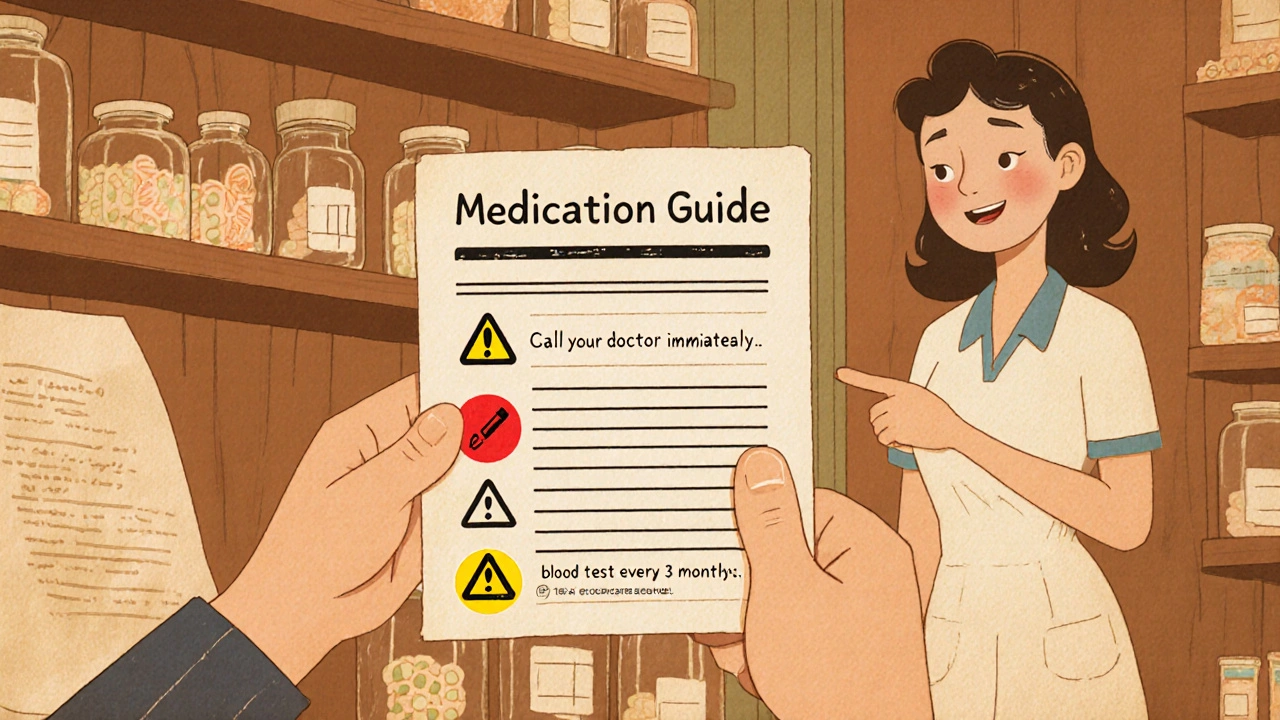
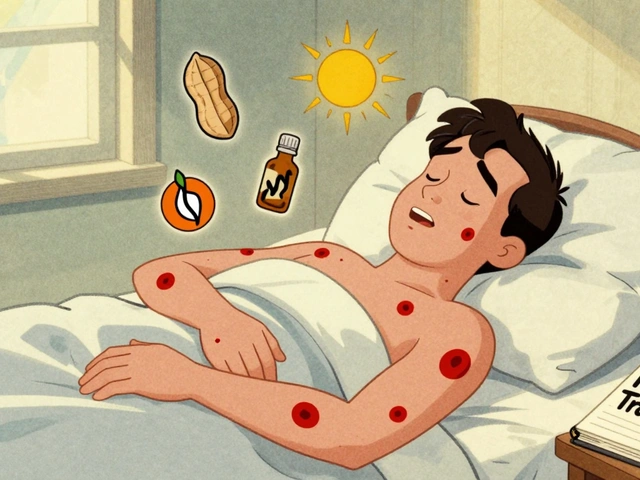


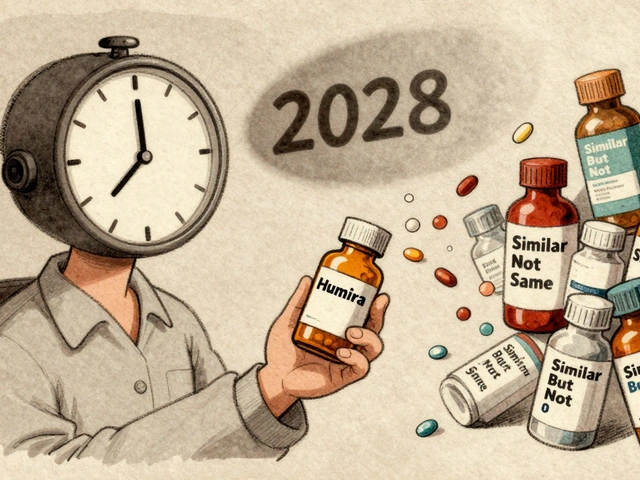

14 Comments
Michael Fitzpatrick
November 22, 2025 at 21:48
Man, I never realized how much I was ignoring those little inserts. I’ve been on blood pressure meds for years and never once read the guide. Guess I thought it was just legal junk. Now I’m going back through every script I’ve got and printing them out. Thanks for the wake-up call.
Holly Schumacher
November 23, 2025 at 15:15
Let me just say this: if you’re not using the traffic light system, you’re not just being lazy-you’re gambling with your life. Yellow means "watch," red means "ER NOW," and green? Green means "keep taking it but don’t get complacent." I’ve saved two friends from hospital trips just by pointing to the red lines. This isn’t advice. It’s survival.
Shawn Daughhetee
November 24, 2025 at 11:22
my pharmacist gave me the guide for my antidepressant but i just tossed it in the drawer. now im gonna pull it out and highlight everything like you said. also my mom has diabetes and she never reads hers either. gonna print one for her too
Miruna Alexandru
November 26, 2025 at 06:43
It’s fascinating how the FDA’s paternalistic approach to patient education reveals a deeper epistemological crisis in modern medicine-where the burden of risk literacy is externalized onto the layperson, while the pharmaceutical-industrial complex retains epistemic authority. The Medication Guide, then, becomes a performative gesture of autonomy masquerading as protection. One wonders if the 55% adherence rate is a triumph… or a tragedy of systemic negligence.
Justin Daniel
November 27, 2025 at 17:44
Hey, I used to think these guides were just filler. Then my buddy almost went into a coma because he skipped his clozapine blood tests. Now I print them out, put them on my fridge with a magnet, and check them every time I take my meds. You don’t need to be a doctor-you just need to care enough to read. Seriously, do it. Your future self will thank you 😊
Melvina Zelee
November 28, 2025 at 21:02
omg i just realized i’ve been on sertraline for 3 years and never read the guide 😭 i thought it was just about side effects like dry mouth but nooo it says if you feel worse in the first 6 weeks you gotta call your doc right away. i’ve been feeling kinda down lately and i just thought it was stress. i’m calling my doctor tomorrow. thanks for making me feel less dumb
steve o'connor
November 30, 2025 at 18:51
Good stuff. I’m from Ireland and we get these guides too, but honestly most folks here just ignore them. I’ve started showing mine to my mates when they’re starting new meds. One guy was on warfarin and didn’t know he couldn’t drink. Now he’s got a little note on his whiskey bottle. Small changes, big difference.
ann smith
December 1, 2025 at 01:29
This is so important 💙 I’ve been a nurse for 18 years and I still read every guide for my own meds. It’s not about fear-it’s about empowerment. If you’re taking something that can change your life, you deserve to know how. Bookmark DailyMed. Set reminders. Share with loved ones. You’re not just a patient-you’re the CEO of your health. Keep going! 🙌
Julie Pulvino
December 1, 2025 at 03:15
i never thought about checking for updates. i’ve been on my thyroid med for 5 years and never looked again. just now went to dailymed and found a new warning about interactions with calcium supplements. whoa. i’ve been taking them together. gonna call my doc. thanks for the nudge!
Patrick Marsh
December 2, 2025 at 18:16
Pharmacies are legally required to provide these. Always ask. Always. If they say no, ask again. Then ask for the manager. Document it. You have rights.
Danny Nicholls
December 4, 2025 at 06:53
just downloaded the guide for my new anticoagulant and saved it to my phone notes 😎 also printed it and stuck it on my pill organizer. i even made a qr code that links to dailymed so my sis can scan it if she ever helps me. small effort, huge safety net 🚨💊
Robin Johnson
December 5, 2025 at 13:41
You’re not overthinking this. You’re thinking correctly. Medication Guides aren’t optional reading-they’re your insurance policy against silent killers. If you’re not tracking your labs or watching for red-flag symptoms, you’re playing Russian roulette with your organs. I’ve seen too many people ignore this. Don’t be one of them.
Latonya Elarms-Radford
December 6, 2025 at 16:30
Let’s be honest: the FDA doesn’t care about you. They care about liability. The Medication Guide is a legal shield for Big Pharma, wrapped in the velvet glove of "patient empowerment." It’s performative safety-designed to absolve corporations while leaving you, the individual, to shoulder the emotional, cognitive, and logistical burden of self-surveillance. You’re not being informed. You’re being weaponized by bureaucracy. And yet… somehow… reading it anyway feels like rebellion.
Holly Schumacher
December 6, 2025 at 20:35
And don’t even get me started on the AI pilot programs. Pfizer’s "personalized" guide? That’s just a fancy algorithm filtering out the scary stuff so you feel better about taking a drug that could kill you. It’s not empowerment-it’s sedation by data. The real safety net is still the guide you print out and circle in red. No AI can replace human vigilance.